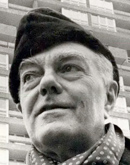

Ernő Goldfinger
*11. 9. 1902 – Budapest, Hungary
†15. 11. 1987 – London, United Kingdom
Biography
Ernő Goldfinger's professional career closely follows the development of global modernity. He was born in 1902 in Budapest in the Austro-Hungarian monarchy. The family moved to Paris, where the young Ernö attended the renowned Beaux-Arts. He spent another fourteen years in the French metropolis, which shaped both his personal and professional journey. Here, he met Le Corbusier. He was among the young architects who expressed their dissatisfaction with the conservatism and outdatedness of Beaux-Arts. He worked with Auguste Perret - a man who was among the first to use reinforced concrete. Perret held the belief that architects should show what elements their buildings were made of. Clarity in structure later became characteristic for both Goldfinger and the influential Alison and Peter Smithson. He was the secretary of the French delegation to CIAM 1933 (Congres Internationaux d'Architecture Moderne). A year later, Ernő moved with his wife Ursula Blackwell to London, where he immediately joined the British branch of MARS (Modern Architectural Research Society). Ursula, whose family co-owned the food empire Crosse & Blackwell, provided financial support for the family at a time when Ernő was struggling to secure commissions in pre-war Britain. He was, like the main political stream after World War II, a supporter of the left, yet he remained a source of few commissions. His former colleagues, who had started in his office, fared much better. However, Goldfinger persisted and, with public authorities eager for high-rise residential buildings behind him (he built his first structure taller than five stories at the age of 54), he completed three significant London projects in the 1960s, his most productive period: Alexander Fleming House, Balfron Tower (146 apartments, 26 stories), and its sister Trellick Tower (175 apartments, 31 stories).
Ernő Goldfinger's professional career closely follows the development of global modernity. He was born in 1902 in Budapest in the Austro-Hungarian monarchy. The family moved to Paris, where the young Ernö attended the renowned Beaux-Arts. He spent another fourteen years in the French metropolis, which shaped both his personal and professional journey. Here, he met Le Corbusier. He was among the young architects who expressed their dissatisfaction with the conservatism and outdatedness of Beaux-Arts. He worked with Auguste Perret - a man who was among the first to use reinforced concrete. Perret held the belief that architects should show what elements their buildings were made of. Clarity in structure later became characteristic for both Goldfinger and the influential Alison and Peter Smithson. He was the secretary of the French delegation to CIAM 1933 (Congres Internationaux d'Architecture Moderne). A year later, Ernő moved with his wife Ursula Blackwell to London, where he immediately joined the British branch of MARS (Modern Architectural Research Society). Ursula, whose family co-owned the food empire Crosse & Blackwell, provided financial support for the family at a time when Ernő was struggling to secure commissions in pre-war Britain. He was, like the main political stream after World War II, a supporter of the left, yet he remained a source of few commissions. His former colleagues, who had started in his office, fared much better. However, Goldfinger persisted and, with public authorities eager for high-rise residential buildings behind him (he built his first structure taller than five stories at the age of 54), he completed three significant London projects in the 1960s, his most productive period: Alexander Fleming House, Balfron Tower (146 apartments, 26 stories), and its sister Trellick Tower (175 apartments, 31 stories).
The English translation is powered by AI tool. Switch to Czech to view the original text source.
Realizations and projects
0 comments
add comment











